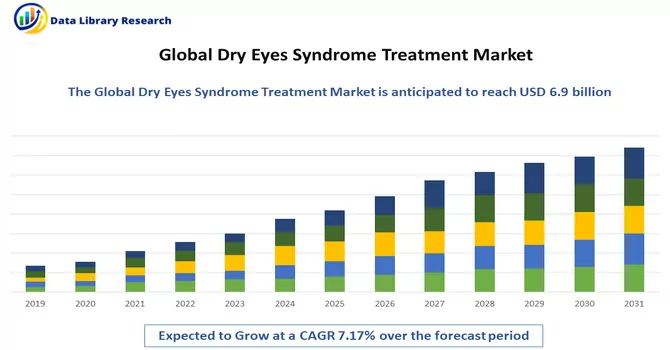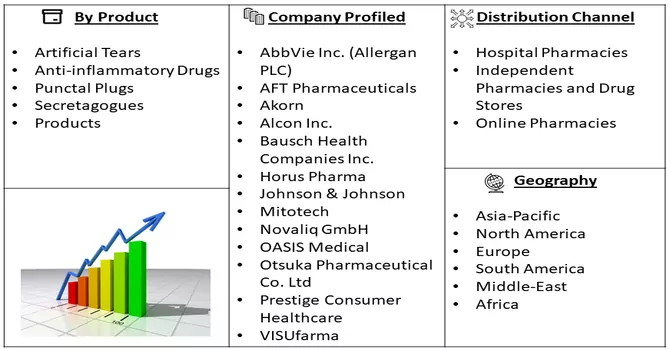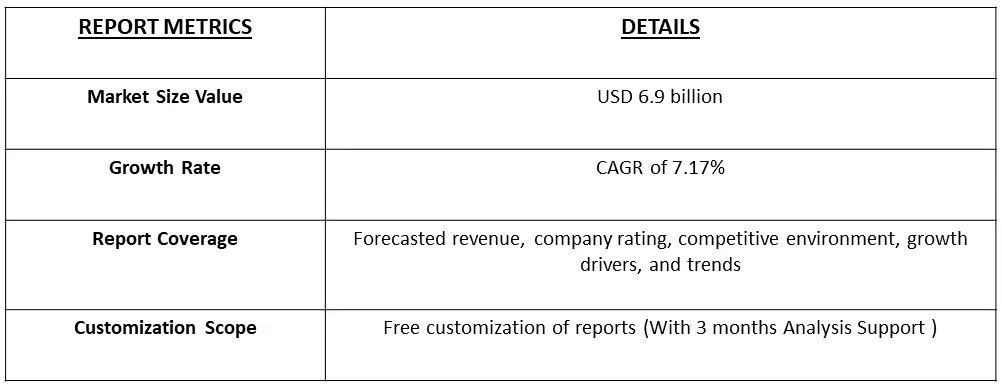The Dry Eyes Syndrome market size was valued at USD 6.9 billion in 2023 and is projected to register a CAGR of 7.17% during 2024-2031.

Get Complete Analysis Of The Report - Download Free Sample PDF
The dry eye syndrome treatment market encompasses a range of therapeutic options aimed at addressing the multifactorial nature of this prevalent ocular condition. With a growing aging population and increasing prevalence of digital device usage, dry eye syndrome has emerged as a significant healthcare concern worldwide.
Market players are focused on developing innovative treatments to alleviate symptoms and improve patients' quality of life. Traditional treatment modalities such as artificial tears and lubricating eye drops remain widely used, but advancements in pharmaceuticals, including prescription medications like cyclosporine and lifitegrast, have expanded treatment options. Additionally, procedures such as punctal plugs insertion and intense pulsed light therapy have gained traction for more severe cases. The market is also witnessing a surge in interest in regenerative medicine approaches, including stem cell therapy and amniotic membrane transplantation, which hold promise for addressing the underlying causes of dry eye syndrome. Moreover, increased awareness among both patients and healthcare professionals, coupled with a growing emphasis on preventive eye care, is driving market growth. However, challenges such as the high cost of prescription medications and limited insurance coverage in some regions may hinder market expansion. Overall, the dry eye syndrome treatment market is characterized by ongoing innovation and a concerted effort to meet the evolving needs of patients suffering from this prevalent ocular condition.
Market Segmentation: The Dry Eye Syndrome Treatment Market is Segmented by Product (Artificial Tears, Anti-inflammatory Drugs, Punctal Plugs, Secretagogues, and Other Products), Distribution Channel (Hospital Pharmacies, Independent Pharmacies and Drug Stores, and Online Pharmacies), and Geography (North America, Europe, Asia-Pacific, Middle-East and Africa, and South America). The report offers the value in USD million for the above segments.

For Detailed Market Segmentation - Download Free Sample PDF
In the dry eye syndrome treatment market, several notable trends are shaping the landscape. Firstly, there is a growing emphasis on personalized treatment approaches tailored to individual patient needs. With advancements in diagnostic technologies such as tear film analysis and imaging modalities, healthcare providers are better equipped to assess the underlying causes of dry eye and customize treatment plans accordingly. Additionally, there is increasing adoption of innovative drug delivery systems, such as liposomal formulations and sustained-release implants, which enhance the efficacy and duration of therapeutic agents. Furthermore, there is a notable shift towards combination therapies that target multiple aspects of the disease pathology simultaneously, offering improved symptomatic relief and disease management. Moreover, the market is witnessing a rise in the use of novel therapeutic modalities, including regenerative medicine techniques like platelet-rich plasma and autologous serum eye drops, which hold promise for addressing underlying tissue damage and promoting ocular surface healing. Finally, with the advent of telemedicine and remote monitoring technologies, there is a growing trend towards decentralized care delivery models, allowing patients greater access to specialized dry eye treatment expertise regardless of geographical location. Overall, these trends reflect the dynamic nature of the dry eye syndrome treatment market and the ongoing pursuit of innovative solutions to meet the evolving needs of patients and healthcare providers.
Market Drivers:
Aging Population
The global population is aging, leading to an increased prevalence of dry eye syndrome as individuals grow older. Aging is associated with changes in tear composition, reduced tear production, and alterations in ocular surface integrity, all of which contribute to the development of dry eye symptoms. As the elderly population grows, there is a corresponding rise in the demand for effective dry eye treatments, driving market growth.
Rising Awareness and Diagnosis
There is growing awareness among both patients and healthcare professionals about the impact of dry eye syndrome on ocular health and overall quality of life. Increased awareness has led to more individuals seeking medical attention for dry eye symptoms, resulting in higher rates of diagnosis. Additionally, advancements in diagnostic technologies have improved the accuracy of dry eye diagnosis, enabling healthcare providers to identify and treat the condition more effectively. As a result, the expanding pool of diagnosed patients is driving market demand for innovative dry eye treatments.
Market Restraints:
One significant market restraint for the dry eye syndrome treatment market is the availability of over-the-counter (OTC) remedies and home remedies. Many individuals experiencing mild to moderate dry eye symptoms may opt for self-medication with OTC eye drops or home remedies before seeking medical intervention. This preference for self-treatment can limit the demand for prescription medications and medical devices used in professional treatment settings. Furthermore, the effectiveness of some OTC remedies and home remedies may vary, leading to inconsistent treatment outcomes and potentially delaying proper diagnosis and management by healthcare professionals. As a result, the prevalence of self-medication practices poses a challenge to the growth of the dry eye syndrome treatment market by diverting potential patients away from professional treatment options. Additionally, reimbursement challenges and the high cost of prescription medications or medical procedures for dry eye treatment may also hinder market expansion, particularly for patients with limited financial resources or inadequate insurance coverage.
The COVID-19 pandemic has had a notable impact on the dry eye syndrome treatment market. With the implementation of public health measures such as lockdowns and social distancing protocols, there has been a decrease in outdoor activities and increased screen time among individuals, leading to a higher prevalence of dry eye symptoms. Additionally, the widespread use of face masks may exacerbate dry eye symptoms by causing air to flow upward, increasing tear evaporation. Moreover, disruptions in healthcare services and patients' reluctance to visit healthcare facilities for non-emergency conditions have led to delays in diagnosis and treatment of dry eye syndrome. However, telemedicine and virtual consultations have emerged as alternative platforms for patient-doctor interactions, mitigating some of the challenges in accessing healthcare services. Overall, while the COVID-19 pandemic has presented obstacles to the dry eye syndrome treatment market, it has also accelerated the adoption of telemedicine and digital health solutions, providing opportunities for innovation and growth in the long term.
Segmental Analysis:
Artificial Tears Segment is Expected to Witness Significant Growth Over the Forecast Period
Dry eye syndrome (DES) occurs when the eyes do not produce enough tears or when tears evaporate too quickly, leading to discomfort and potential damage to the cornea. Artificial tears, available over-the-counter, provide relief by lubricating the eyes and maintaining moisture. DES can be caused by various factors such as age, gender, environmental conditions, and medications. Treatment options include prescription medications, punctal plugs, and moisturizing ointments. Prevention tips include using a humidifier, taking breaks from digital devices, wearing sunglasses outdoors, and staying hydrated. If symptoms persist, it is important to seek professional medical advice.
North America Region is Expected to Witness Significant Growth Over the Forecast Period
North America is poised to dominate the dry eye disease (DED) market, driven by its high prevalence in the region and the ready availability of solutions. The widespread use of computers and digital screens has led to reduced blinking, contributing to DED symptoms and increasing the demand for effective therapeutics. A Cureus Journal article from July 2022 estimated DED prevalence at 21% in Canada, with women using eye cosmetics at a higher risk. This trend underscores cosmetics as a risk factor for DED development. The market is further fueled by key drug launches, such as Kala Pharmaceuticals Inc.'s EYSUVIS (loteprednol etabonate ophthalmic suspension) 0.25%, launched in January 2021 for short-term DED treatment. EYSUVIS is available in US distribution centers, accessible to patients through local pharmacies or home delivery. Similarly, in January 2022, Sun Pharma Canada Inc. launched Cequa (cyclosporine ophthalmic solution 0.09%), an immunomodulator. These novel products are expected to give North America a competitive edge in the market, driving significant growth over the forecast period.

For Detailed Market Segmentation - Download Free Sample PDF
The analyzed market exhibits a high degree of fragmentation, primarily attributable to the presence of numerous players operating on both a global and regional scale. The competitive landscape is characterized by a diverse array of companies, each contributing to the overall market dynamics. This fragmentation arises from the existence of specialized solution providers, established industry players, and emerging entrants, all vying for market share. The diversity in market participants is underscored by the adoption of various strategies aimed at expanding the company presence. On a global scale, companies within the studied market are strategically positioning themselves through aggressive expansion initiatives. This often involves entering new geographical regions, targeting untapped markets, and establishing a robust global footprint. The pursuit of global expansion is driven by the recognition of diverse market opportunities and the desire to capitalize on emerging trends and demands across different regions. Simultaneously, at the regional level, companies are tailoring their approaches to align with local market dynamics. Regional players are leveraging their understanding of specific market nuances, regulatory environments, and consumer preferences to gain a competitive edge. This regional focus allows companies to cater to the unique needs of local clientele, fostering stronger market penetration. To navigate the complexities of the fragmented market, companies are implementing a range of strategies. These strategies include investments in research and development to stay at the forefront of technological advancements, mergers and acquisitions to consolidate market share, strategic partnerships for synergies, and innovation to differentiate products and services. The adoption of such multifaceted strategies reflects the competitive nature of the market, with participants continually seeking avenues for growth and sustainability. In essence, the high fragmentation in the studied market not only signifies the diversity of players but also underscores the dynamism and competitiveness that drive ongoing strategic maneuvers. As companies explore various avenues for expansion, the market continues to evolve, presenting both challenges and opportunities for industry stakeholders
Some of the major players working in this market segment are:
1) In October 2022, Aldeyra Therapeutics, Inc. successfully concluded the phase 3 clinical trial for 0.25% reproxalap ophthalmic solution, an investigational new drug candidate aimed at treating allergic conjunctivitis. The company unveiled the clinical trial data at the American Academy of Optometry 2022 Annual Meeting, showcasing promising results in the treatment of this condition.
2) In January 2022, NovaBay Pharmaceuticals introduced Avenova lubricating eye drops, a new product designed to alleviate symptoms of dry eyes. This launch represents a significant addition to the market for dry eye treatments, offering patients a new option for managing this common and uncomfortable condition.
Q1. What was the Dry Eyes Syndrome Treatment Market size in 2023?
As per Data Library Research the Dry Eyes Syndrome market size was valued at USD 6.9 billion in 2023.
Q2. At what CAGR is the Dry Eyes Syndrome Treatment market projected to grow within the forecast period?
Dry Eyes Syndrome Treatment is projected to register a CAGR of 7.17% over the forecast period.
Q3. What segments are covered in the Dry Eyes Syndrome Treatment Market Report?
By Product, Dustribution Channel and Geography these segments are covered in the Dry Eyes Syndrome Treatment Market Report.
Q4. What are the Growth Drivers of the Dry Eyes Syndrome Treatment Market?
Aging Population and Rising Awareness and Diagnosis are the Growth Drivers of the Dry Eyes Syndrome Treatment Market.
Data Library Research are conducted by industry experts who offer insight on industry structure, market segmentations technology assessment and competitive landscape (CL), and penetration, as well as on emerging trends. Their analysis is based on primary interviews (~ 80%) and secondary research (~ 20%) as well as years of professional expertise in their respective industries. Adding to this, by analysing historical trends and current market positions, our analysts predict where the market will be headed for the next five years. Furthermore, the varying trends of segment & categories geographically presented are also studied and the estimated based on the primary & secondary research.
In this particular report from the supply side Data Library Research has conducted primary surveys (interviews) with the key level executives (VP, CEO’s, Marketing Director, Business Development Manager and SOFT) of the companies that active & prominent as well as the midsized organization
FIGURE 1: DLR RESEARH PROCESS

Extensive primary research was conducted to gain a deeper insight of the market and industry performance. The analysis is based on both primary and secondary research as well as years of professional expertise in the respective industries.
In addition to analysing current and historical trends, our analysts predict where the market is headed over the next five years.
It varies by segment for these categories geographically presented in the list of market tables. Speaking about this particular report we have conducted primary surveys (interviews) with the key level executives (VP, CEO’s, Marketing Director, Business Development Manager and many more) of the major players active in the market.
Secondary ResearchSecondary research was mainly used to collect and identify information useful for the extensive, technical, market-oriented, and Friend’s study of the Global Extra Neutral Alcohol. It was also used to obtain key information about major players, market classification and segmentation according to the industry trends, geographical markets, and developments related to the market and technology perspectives. For this study, analysts have gathered information from various credible sources, such as annual reports, sec filings, journals, white papers, SOFT presentations, and company web sites.
Market Size EstimationBoth, top-down and bottom-up approaches were used to estimate and validate the size of the Global market and to estimate the size of various other dependent submarkets in the overall Extra Neutral Alcohol. The key players in the market were identified through secondary research and their market contributions in the respective geographies were determined through primary and secondary research.
Forecast Model
